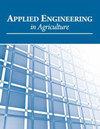Asynchronous Overlapping: An Image Segmentation Method for Key Feature Regions of Plant Phenotyping
IF 0.9
4区 农林科学
Q4 AGRICULTURAL ENGINEERING
引用次数: 0
Abstract
Highlights Asynchronous overlapping—an automatic image acquisition method for key feature regions of plant phenotypes. The distance from the plant to the camera can be characterized by the brightness in the grayscale image. Asynchronously acquire daytime RGB and nighttime grayscale images of the plant to use the proposed algorithm. In the test of the plant images, the IoU is 0.8497, reaching a similar level of interactive algorithms. Abstract. Acquiring and describing plant phenotyping is an important proposition in botany and agronomy research. In this study, a computer vision-based asynchronous overlapping segmentation algorithm is proposed for automatic image acquisition of key feature regions of plant phenotyping. Firstly, day-time RGB and night-time grayscale images of infrared light filling the crop body at the same angle are asynchronously obtained using a common closed-circuit television surveillance camera. Then, thresholding and morphological filtering of grayscale images are conducted to extract the initial region contours. With this as a precondition, the algorithm adaptively finds edge paths of key feature regions in daytime RGB images. In the test of the cherry plant image, the intersection over union (IoU) of the algorithm to segment the key feature regions is 0.8497, reaching a similar level of interactive algorithms that require human involvement. The proposed method has low cost, high segmentation accuracy, and strong applicability. The proposed method can independently realize the acquisition of the key feature regions of plant image phenotypes and can be applied to large-scale agricultural production.异步重叠:植物表型关键特征区域的图像分割方法
异步重叠-植物表型关键特征区域的自动图像采集方法。从植物到相机的距离可以通过灰度图像中的亮度来表征。采用该算法异步获取植物的日间RGB和夜间灰度图像。在对植物图像的测试中,IoU为0.8497,达到了与交互式算法相似的水平。摘要植物表型的获取和描述是植物学和农学研究中的一个重要课题。本文提出了一种基于计算机视觉的异步重叠分割算法,用于植物表型关键特征区域的图像自动获取。首先,利用普通闭路电视监控摄像机,异步获取相同角度的红外光填充作物体的日间RGB和夜间灰度图像;然后对灰度图像进行阈值分割和形态学滤波,提取初始区域轮廓;在此前提下,该算法自适应地找到白天RGB图像中关键特征区域的边缘路径。在对樱桃植物图像的测试中,该算法分割关键特征区域的IoU (intersection over union)为0.8497,达到了与需要人工参与的交互式算法相似的水平。该方法成本低,分割精度高,适用性强。该方法可独立实现植物图像表型关键特征区域的获取,可应用于大规模农业生产。
本文章由计算机程序翻译,如有差异,请以英文原文为准。
求助全文
约1分钟内获得全文
求助全文
来源期刊

Applied Engineering in Agriculture
农林科学-农业工程
CiteScore
1.80
自引率
11.10%
发文量
69
审稿时长
6 months
期刊介绍:
This peer-reviewed journal publishes applications of engineering and technology research that address agricultural, food, and biological systems problems. Submissions must include results of practical experiences, tests, or trials presented in a manner and style that will allow easy adaptation by others; results of reviews or studies of installations or applications with substantially new or significant information not readily available in other refereed publications; or a description of successful methods of techniques of education, outreach, or technology transfer.
 求助内容:
求助内容: 应助结果提醒方式:
应助结果提醒方式:


